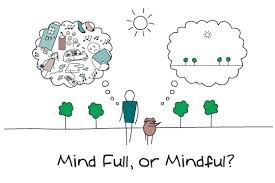Week 4
Moving beyond the rumor mill
The way we interpret the world makes a huge difference to how we react. This is sometimes called the ABC model of emotions.
The “A” represents the situation itself – what a video camera would record.
The “B” is the interpretation given to the scene; the running story we create out of the situation, which often flows just beneath the surface of awareness but is taken as a fact.
The “C” is our reactions: our emotions, body sensations and our impulses to act in various ways.
Often we see the “A” and the “C” quite clearly, but we are not aware of the “B”. We think that the situations itself aroused our feelings and emotions when, in fact, it was our interpretation of the scene that did this.
The minds running commentary on the world is like a rumour. It might be true, it might only be partially true – or it might be completely wrong. Unfortunately, the mind often finds it very difficult to detect the difference between the fact and fiction once it has begun to construct the mental model of the world. For these reasons, rumours can be incredibly powerful and derail not just the minds of individuals but of whole societies.
Our thoughts are like rumors in the mind. They might be true, but then again, they might not be.
Mindfulness helps us get better at seeing the difference between what’s happening and the stories we tell ourselves about what’s happening, stories that get in the way of direct experience. (Adapted from "Living mindfully in frantic world").
We can't control the thoughts entering our minds, but we have control over what will we do with them once they are here, we have a choice following them or not. Mindfulness gives us options and freedom to choose.
There is nothing either good or bad but thinking makes it so. Shakespeare
The two arrows:
The Buddha once asked, "If a person is struck by an arrow, is that painful?" Yes. The Buddha then
asked, "If the person is struck by a second arrow, is that even more painful?" Of course. He went on to
say, that as long as we are alive, we can expect painful experiences - the first arrow. Often the significant
suffering associated with an emotion is not the emotion itself, but the way we relate to it. If we condemn,
judge, hate, or deny the first arrow, that is like being struck by a second arrow. The second arrow is
optional, and mindfulness helps us avoid it.
Pain is inevitable, but suffering is optional!
Practices for week 4:
1. Breath and Body meditation followed by Sounds and thoughts meditation. (Meditation 4 and 5 ), at least once during the week listen to 20 min meditation on observing thoughts by Jon Kabat-Zinn
2. 3 minute breathing space (Meditation 8) to be practiced in a stressful situation, ex before a meeting, presentation, exam, in a traffic jam etc.
3. Become aware of the stories the mind creates, especially the negative ones and what emotions arise as a result. Think of the ABC model and 2 arrows.
Science of meditation 3 min video
5.28 min video about the thoughts by Jon Kabat-Zinn
An article on Mindfulness by a Trinity graduate
7 min video "How my son ruined my life-confessions of a Jewish mother
TED talk Dan Gilbert - The surprising science of happiness
Podcast by Gerry Hussey
Telling Harsh Stories to Yours…–10% Happier with Dan Harris – Apple Podcasts

